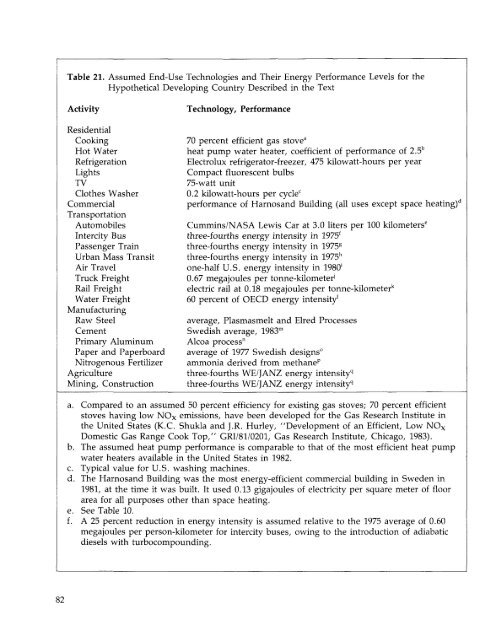ENERGY FOR A SUSTAINABLE WORLD - World Resources Institute
ENERGY FOR A SUSTAINABLE WORLD - World Resources Institute
ENERGY FOR A SUSTAINABLE WORLD - World Resources Institute
You also want an ePaper? Increase the reach of your titles
YUMPU automatically turns print PDFs into web optimized ePapers that Google loves.
Table 21. Assumed End-Use Technologies and Their Energy Performance Levels for the<br />
Hypothetical Developing Country Described in the Text<br />
Activity<br />
Residential<br />
Cooking<br />
Hot Water<br />
Refrigeration<br />
Lights<br />
TV<br />
Clothes Washer<br />
Commercial<br />
Transportation<br />
Automobiles<br />
Intercity Bus<br />
Passenger Train<br />
Urban Mass Transit<br />
Air Travel<br />
Truck Freight<br />
Rail Freight<br />
Water Freight<br />
Manufacturing<br />
Raw Steel<br />
Cement<br />
Primary Aluminum<br />
Paper and Paperboard<br />
Nitrogenous Fertilizer<br />
Agriculture<br />
Mining, Construction<br />
Technology, Performance<br />
70 percent efficient gas stove 3<br />
heat pump water heater, coefficient of performance of 2.5 b<br />
Electrolux refrigerator-freezer, 475 kilowatt-hours per year<br />
Compact fluorescent bulbs<br />
75-watt unit<br />
0.2 kilowatt-hours per cycle c<br />
performance of Harnosand Building (all uses except space heating) d<br />
Cummins/NASA Lewis Car at 3.0 liters per 100 kilometers 6<br />
three-fourths energy intensity in 1975 £<br />
three-fourths energy intensity in 1975 s<br />
three-fourths energy intensity in 1975 h<br />
one-half U.S. energy intensity in 1980'<br />
0.67 megajoules per tonne-kilometer'<br />
electric rail at 0.18 megajoules per tonne-kilometer k<br />
60 percent of OECD energy intensity'<br />
average, Plasmasmelt and Elred Processes<br />
Swedish average, 1983 m<br />
Alcoa process"<br />
average of 1977 Swedish designs 0<br />
ammonia derived from methane p<br />
three-fourths WE/JANZ energy intensity 9<br />
three-fourths WE/JANZ energy intensity 9<br />
a. Compared to an assumed 50 percent efficiency for existing gas stoves; 70 percent efficient<br />
stoves having low NO X emissions, have been developed for the Gas Research <strong>Institute</strong> in<br />
the United States (K.C. Shukla and J.R. Hurley, "Development of an Efficient, Low NO X<br />
Domestic Gas Range Cook Top," GRI/81/0201, Gas Research <strong>Institute</strong>, Chicago, 1983).<br />
b. The assumed heat pump performance is comparable to that of the most efficient heat pump<br />
water heaters available in the United States in 1982.<br />
c. Typical value for U.S. washing machines.<br />
d. The Harnosand Building was the most energy-efficient commercial building in Sweden in<br />
1981, at the time it was built. It used 0.13 gigajoules of electricity per square meter of floor<br />
area for all purposes other than space heating.<br />
e. See Table 10.<br />
f. A 25 percent reduction in energy intensity is assumed relative to the 1975 average of 0.60<br />
megajoules per person-kilometer for intercity buses, owing to the introduction of adiabatic<br />
diesels with turbocompounding.<br />
82

















